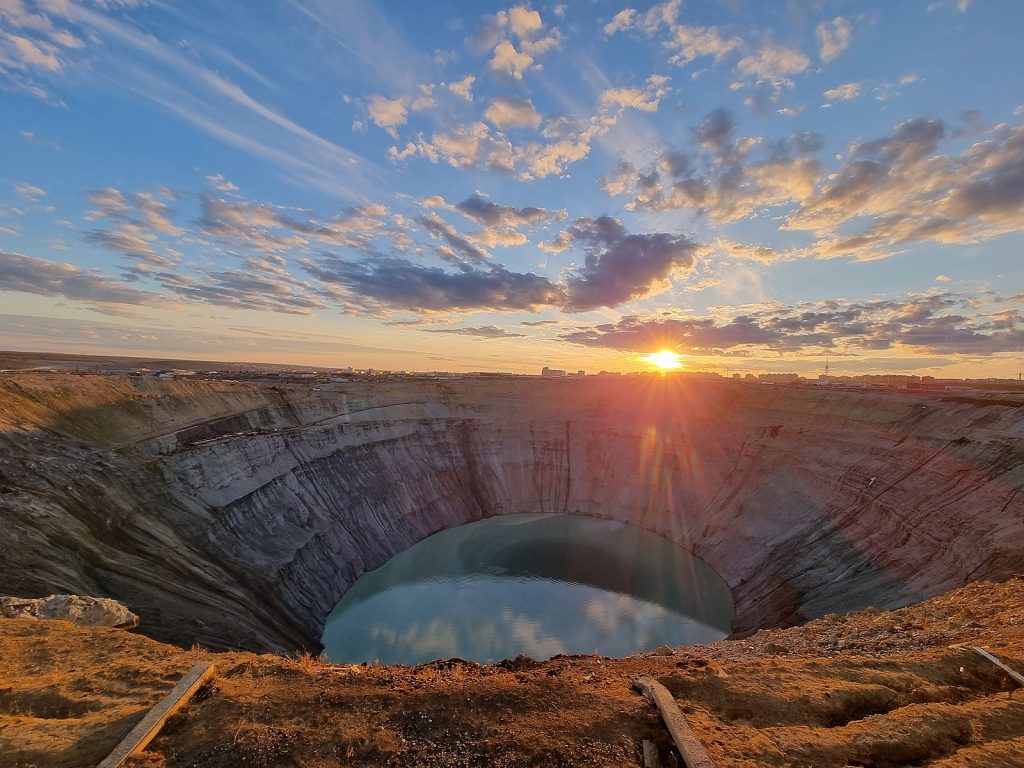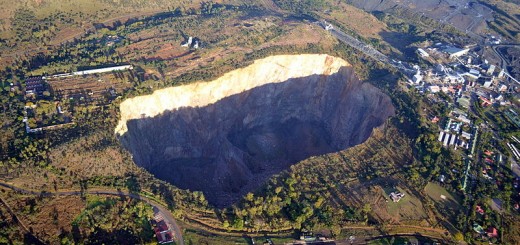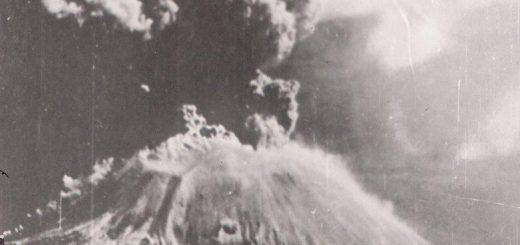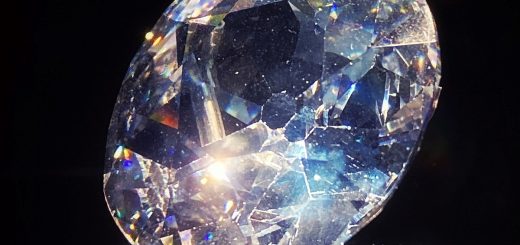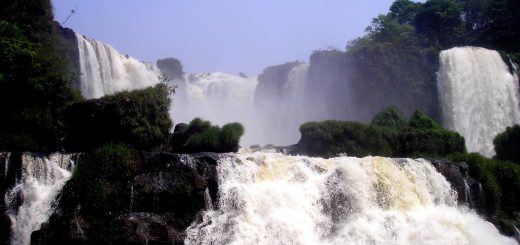Deepest Siberia’s Mirny Mine: Where Helicopters Fear to Fly
Nestled deep within the harsh, unforgiving landscape of eastern Russia’s Sakha Republic lies the awe-inspiring deepest diamond mine the “Mirny Mine“. Known locally as the “Mir Mine,” this extraordinary pit has captured the imagination of the world as one of the largest and deepest open-pit diamond mines ever excavated.
Discovering the Treasure Trove of Mirny Mine
The tale of the Mirny Mine began on June 13, 1955, when a team of intrepid Soviet geologists, including Yuri Khabardin, Ekaterina Elagina, and Viktor Avdeenko, embarked on the ambitious Amakinsky Expedition in the Yakut ASSR. Their mission? To unearth the coveted gems hidden deep within the Earth’s crust.
Their breakthrough came when they stumbled upon traces of kimberlite, a volcanic rock associated with the formation of diamonds. This pivotal discovery marked a turning point in Russia’s quest for kimberlite, following numerous failed expeditions in the preceding decades. Yuri Khabardin’s remarkable contribution earned him the prestigious Lenin Prize in 1957, a testament to the significance of their find.
The Challenging Road to Development
Embarking on the journey to develop the Mir Mine was no small feat. The inhospitable Siberian climate meant enduring seven months of bone-chilling winters, where the ground froze solid, making excavation near-impossible. During the fleeting summer months, the ground transformed into a quagmire, posing yet another set of challenges.
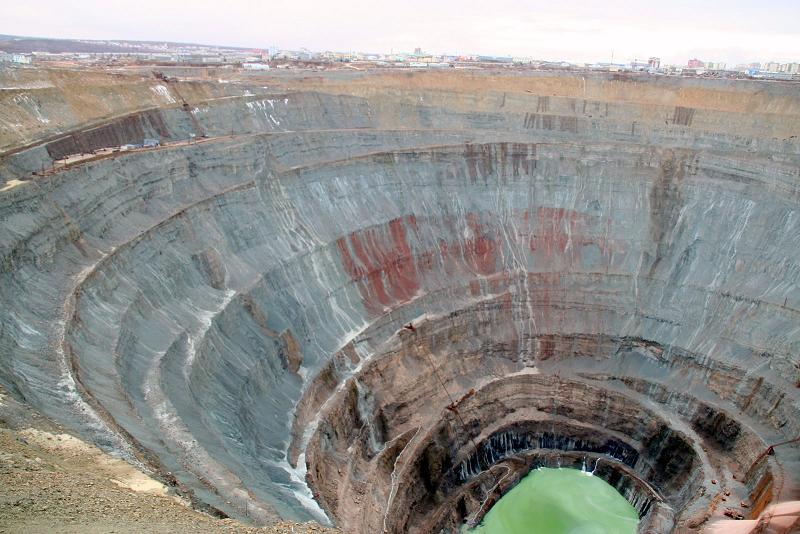
To tackle these adversities, ingenious methods were employed. Buildings were constructed on piles to prevent them from sinking into the thawing permafrost. The primary processing plant, crucial for diamond extraction, was situated 20 kilometers away from the mine on more stable ground. In the heart of winter, workers had to employ jet engines to thaw and excavate the permafrost or resort to dynamite to access the underlying kimberlite. Even the machinery had to be covered at night to prevent freezing.
The Glorious Days of Diamond Production
In the 1960s, the Mir Mine was in its prime, producing a staggering 10,000,000 carats of diamonds annually, with a remarkable 20% of them being of gem quality. The upper layers of the mine were especially rich, boasting a diamond content of four carats per tonne of ore, with a high ratio of gem-quality stones. As the operation descended further into the pit, the yield decreased to approximately 2 carats per tonne, with an annual production rate of 2,000,000 carats.
The pinnacle of this mine’s legacy was reached on December 23, 1980, when miners unearthed a colossal diamond weighing 342.5 carats, aptly named the “26th Congress of the Communist Party of the Soviet Union.” It established an enduring symbol of the mine’s success.
Shifting Gears: Underground Mining and Modern Times
Surface mining at the Mir Mine concluded in June 2001, marking the end of an era. Following the dissolution of the USSR, the mine was operated by the Sakha diamond company, reaping annual profits exceeding $600 million from diamond sales.
Later, the baton was passed to Alrosa, Russia’s premier diamond producer. Recognizing the limitations of surface mining, construction of an extensive network of tunnels for underground diamond recovery commenced in the 1970s. By 1999, the project exclusively operated as an underground mine. To stabilize the abandoned surface main pit, a colossal 45-meter-thick rubble layer was deployed.
Intriguingly, the Mir Mine experienced a revival in 2009, with expectations of remaining operational for an additional 50 years. However, it faced a dramatic setback in 2017 when the underground mine flooded, trapping over 140 miners. Thankfully, all but 8 were rescued, underlining the inherent challenges of working in this subterranean marvel.
As we contemplate the history of the Mir Mine, from its inception by daring geologists to its transition into a modern underground gem, we are left in awe of the human spirit’s indomitable will and determination. This Siberian titan, this colossal scar on the Earth’s surface, continues to captivate our imagination as it unveils its sparkling treasures from the depths of the Russian wilderness.
A New Beginning: Recommissioning and Hope
After a brief hiatus, the Mirny Mine was recommissioned in 2009 and is expected to remain operational for another 50 years. However, challenges persist. The mine faced a severe setback in 2017 when it flooded, trapping over 140 miners. Thankfully, all but eight were rescued, highlighting the ongoing risks and rewards associated with this remarkable diamond treasure.
The Mirny Mine’s journey from discovery to the present day is a testament to human resilience and the relentless pursuit of diamonds. It’s a story of conquering nature’s harshest conditions and unearthing the Earth’s hidden treasures. Mirny Mine is not just a mine; it’s a living legend that continues to captivate the world with its remarkable tale.
Conclusion
The second-largest excavated pit in the world, Mirny Mine, is an incredible example of human ingenuity and the quest of geological marvels. Its enormous size and abundant diamond reserves have fascinated and inspired countless generations of explorers, geologists, and mining enthusiasts. Currently, Mirny Mine serves as a singular example of how human inventiveness and the remarkable geological history of our planet can coexist, serving as a reminder that there are yet uncharted depths to explore beneath the Earth’s surface.

